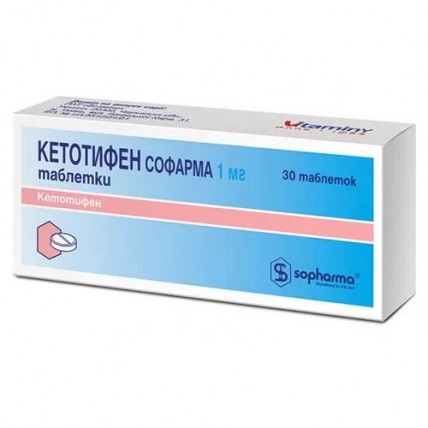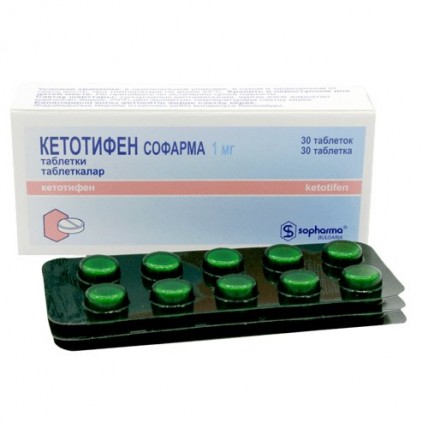Ketotifen Sopharma 1 mg (30 tablets)
- $17.00
One tablet contains
Ketotifen belongs to the group of cycloheptathiophenones and has a strong antihistamine effect. The mechanism of its action is associated with inhibition of the release of histamine and other mediators from mast cells, with blocking of histamine H1 receptors and suppression of the phosphodiesterase enzyme, resulting in an increase in the level of cAMP in mast cells. Suppresses the effects of TAF (platelet-activating factor).
Absorption: It is characterized by almost complete resorption from the gastrointestinal tract, while its bioavailability is about 50% due to the first pass effect through the liver. The maximum plasma level is reached between 2 and 4 hours. The equilibrium state is reached after taking the minimum daily dose of 2 mg.
Distribution: Plasma protein binding is about 75%. The volume of distribution is 2.7 l / kg.
Metabolism: About 60% of the dose taken is metabolized in the liver through three pathways: demethylation, N-oxidation, N-glucuron conjugation, to the following metabolites: ketotifen-N-glucuronide (pharmacologically inactive), nor-ketotifen (with pharmacological activity similar to that of unchanged ketotifen ), N-oxide ketotifen and 10-hydroxy ketotifen (with unknown pharmacological activity).
Metabolism in children does not differ from that in adults, with the exception of faster clearance.
Excretion: It is excreted biphasically, with a short half-life of 3 to 5 hours and a longer half-life of 21 hours. About 1% of the substance is excreted unchanged in the urine within 48 hours, and 60 to 70% in the form of metabolites.
Adults:
1 tablet (1 mg) 2 times a day, morning and evening. Tablets are taken orally during meals, washed down with water.
Patients who develop significant sedation are advised to slowly increase the dose during the first week, starting with ½ tablet (0.5 mg) 2 times a day and gradually increasing until a therapeutic dose is reached. If necessary, the daily dose can be increased to 4 mg (4 tablets) per day in 2 divided doses. The maximum daily dose for adults is 4 mg.
Children over 6 years: 1 tablet (1 mg) 2 times a day, morning and evening, with meals. The maximum daily dose for children is 2 mg. In children of a younger age group, according to WHO recommendations, this dosage form is not used.
Duration of treatment: the treatment is long, and the therapeutic effect is achieved after a few weeks of treatment.
Termination of treatment:
Stopping treatment with ketotifen should be gradual to avoid the risk of recurrence of asthmatic symptoms.
Use in elderly patients
There are no special requirements in elderly patients.
The side effects described below are classified by organs and systems and by frequency of occurrence, divided as follows: very frequent (³ 1/10), frequent (³ 1/100 and <1/10), infrequent (³ 1/1 000 and <1/ 100), rare (³ 1/10,000 and <1/1,000), very rare (<1/10,000), frequency unknown (cannot be estimated from existing data).
Often:
- agitation, irritability, insomnia, anxiety.
Infrequently:
-cystitis
-dizziness
-dry mouth.
Rarely:
- increase in body weight
- retardation.
Very rarely:
– severe skin reactions, erythema multiforme, Stevens-Johnson syndrome
- increased levels of liver enzymes, hepatitis
- convulsions.
Dry mouth and dizziness may occur at the start of treatment, but these usually resolve spontaneously with treatment. Rarely, symptoms of CNS stimulation such as agitation, irritability, insomnia and restlessness have been observed, especially in children.
- hypersensitivity to the active substance or any of the excipients
- pregnancy and lactation
- children's age up to 6 years
- thrombocytopenia (when used simultaneously with antidiabetic drugs)
With the simultaneous use of ketotifen and oral antidiabetic agents, there is a risk of developing reversible thrombocytopenia. Such patients need to monitor the number of platelets.
With the combined use of atropine, atropine-like agents and ketotifen, the risk of adverse drug reactions, such as urinary retention, constipation, dry mouth, increases.
Ketotifen may potentiate the effects of other drugs that depress the central nervous system (sedatives, hypnotics).
Its simultaneous use with other antihistamines can lead to mutual potentiation of their effects.
During treatment with ketotifen, alcohol should be avoided, as it enhances the depressive effect of ketotifen on the central nervous system.
In the case of intercurrent infection, specific anti-infective therapy should be carried out.
In very rare cases, seizures have been reported during treatment with ketotifen.
Since ketotifen lowers the seizure threshold, it should be used with extreme caution in patients with a history of seizures.
The wheat starch in the tablet may contain only traces of gluten and is considered safe for individuals with celiac disease.
Pregnancy and lactation
Due to the lack of safety data, the drug is not prescribed during pregnancy and lactation.
Features of the effect of the drug on the ability to drive a vehicle or potentially dangerous mechanisms
At the beginning of treatment, Ketotifen Sopharma may slow down the patient's reactions, which requires increased caution among drivers of vehicles and when working with moving mechanisms.
Symptoms: drowsiness to severe lethargy, confusion and disorientation, nystagmus, headache, tachycardia and hypotension, hyperexcitability or convulsions in children, coma.
Treatment: gastric lavage, activated charcoal. If necessary, symptomatic treatment and monitoring of cardiac activity is recommended. Short-acting barbiturates or benzodiazepines may be used in agitated states.
Store in the original packaging, in a dry and dark place, at a temperature not exceeding 25 ºС.
Keep out of the reach of children!
Shelf life - 3 years
Do not take after the expiration date.
- Active ingredients: Ketotifen hydrofumarate 1.38 mg (equivalent to ketotifen 1 mg),
- Excipients: anhydrous calcium hydrogen phosphate, microcrystalline cellulose (type 200), wheat starch, magnesium stearate.
Pharmacological properties
Pharmacodynamics
Ketotifen belongs to the group of cycloheptathiophenones and has a strong antihistamine effect. The mechanism of its action is associated with inhibition of the release of histamine and other mediators from mast cells, with blocking of histamine H1 receptors and suppression of the phosphodiesterase enzyme, resulting in an increase in the level of cAMP in mast cells. Suppresses the effects of TAF (platelet-activating factor).
Pharmacokinetics
Absorption: It is characterized by almost complete resorption from the gastrointestinal tract, while its bioavailability is about 50% due to the first pass effect through the liver. The maximum plasma level is reached between 2 and 4 hours. The equilibrium state is reached after taking the minimum daily dose of 2 mg.
Distribution: Plasma protein binding is about 75%. The volume of distribution is 2.7 l / kg.
Metabolism: About 60% of the dose taken is metabolized in the liver through three pathways: demethylation, N-oxidation, N-glucuron conjugation, to the following metabolites: ketotifen-N-glucuronide (pharmacologically inactive), nor-ketotifen (with pharmacological activity similar to that of unchanged ketotifen ), N-oxide ketotifen and 10-hydroxy ketotifen (with unknown pharmacological activity).
Metabolism in children does not differ from that in adults, with the exception of faster clearance.
Excretion: It is excreted biphasically, with a short half-life of 3 to 5 hours and a longer half-life of 21 hours. About 1% of the substance is excreted unchanged in the urine within 48 hours, and 60 to 70% in the form of metabolites.
Indications for use
- In the symptomatic treatment of allergic conditions, including allergic rhinitis and conjunctivitis.
Dosage and administration
Adults:
1 tablet (1 mg) 2 times a day, morning and evening. Tablets are taken orally during meals, washed down with water.
Patients who develop significant sedation are advised to slowly increase the dose during the first week, starting with ½ tablet (0.5 mg) 2 times a day and gradually increasing until a therapeutic dose is reached. If necessary, the daily dose can be increased to 4 mg (4 tablets) per day in 2 divided doses. The maximum daily dose for adults is 4 mg.
Children over 6 years: 1 tablet (1 mg) 2 times a day, morning and evening, with meals. The maximum daily dose for children is 2 mg. In children of a younger age group, according to WHO recommendations, this dosage form is not used.
Duration of treatment: the treatment is long, and the therapeutic effect is achieved after a few weeks of treatment.
Termination of treatment:
Stopping treatment with ketotifen should be gradual to avoid the risk of recurrence of asthmatic symptoms.
Use in elderly patients
There are no special requirements in elderly patients.
Possible side effects
The side effects described below are classified by organs and systems and by frequency of occurrence, divided as follows: very frequent (³ 1/10), frequent (³ 1/100 and <1/10), infrequent (³ 1/1 000 and <1/ 100), rare (³ 1/10,000 and <1/1,000), very rare (<1/10,000), frequency unknown (cannot be estimated from existing data).
Often:
- agitation, irritability, insomnia, anxiety.
Infrequently:
-cystitis
-dizziness
-dry mouth.
Rarely:
- increase in body weight
- retardation.
Very rarely:
– severe skin reactions, erythema multiforme, Stevens-Johnson syndrome
- increased levels of liver enzymes, hepatitis
- convulsions.
Dry mouth and dizziness may occur at the start of treatment, but these usually resolve spontaneously with treatment. Rarely, symptoms of CNS stimulation such as agitation, irritability, insomnia and restlessness have been observed, especially in children.
Contraindications
- hypersensitivity to the active substance or any of the excipients
- pregnancy and lactation
- children's age up to 6 years
- thrombocytopenia (when used simultaneously with antidiabetic drugs)
Drug Interactions
With the simultaneous use of ketotifen and oral antidiabetic agents, there is a risk of developing reversible thrombocytopenia. Such patients need to monitor the number of platelets.
With the combined use of atropine, atropine-like agents and ketotifen, the risk of adverse drug reactions, such as urinary retention, constipation, dry mouth, increases.
Ketotifen may potentiate the effects of other drugs that depress the central nervous system (sedatives, hypnotics).
Its simultaneous use with other antihistamines can lead to mutual potentiation of their effects.
During treatment with ketotifen, alcohol should be avoided, as it enhances the depressive effect of ketotifen on the central nervous system.
Special instructions
In the case of intercurrent infection, specific anti-infective therapy should be carried out.
In very rare cases, seizures have been reported during treatment with ketotifen.
Since ketotifen lowers the seizure threshold, it should be used with extreme caution in patients with a history of seizures.
The wheat starch in the tablet may contain only traces of gluten and is considered safe for individuals with celiac disease.
Pregnancy and lactation
Due to the lack of safety data, the drug is not prescribed during pregnancy and lactation.
Features of the effect of the drug on the ability to drive a vehicle or potentially dangerous mechanisms
At the beginning of treatment, Ketotifen Sopharma may slow down the patient's reactions, which requires increased caution among drivers of vehicles and when working with moving mechanisms.
Overdose
Symptoms: drowsiness to severe lethargy, confusion and disorientation, nystagmus, headache, tachycardia and hypotension, hyperexcitability or convulsions in children, coma.
Treatment: gastric lavage, activated charcoal. If necessary, symptomatic treatment and monitoring of cardiac activity is recommended. Short-acting barbiturates or benzodiazepines may be used in agitated states.
Storage conditions
Store in the original packaging, in a dry and dark place, at a temperature not exceeding 25 ºС.
Keep out of the reach of children!
Shelf life - 3 years
Do not take after the expiration date.









